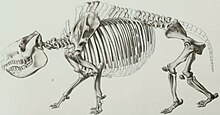| Toxodontidae | |
|---|---|

| |
| Toxodon platensis | |

| |
| Skeleton of Nesodon imbricatus | |
| Scientific classification | |
| Domain: | Eukaryota |
| Kingdom: | Animalia |
| Phylum: | Chordata |
| Class: | Mammalia |
| Order: | †Notoungulata |
| Clade: | †Eutoxodontia |
| Family: | †Toxodontidae Owen 1845 |
| Subfamilies and genera | |
| |

Toxodontidae is an extinct family of notoungulate mammals, known from the Oligocene to the Holocene (11,000 BP) of South America,[1] with one genus, Mixotoxodon, also known from the Pleistocene of Central America and southern North America (as far north as Texas).[2] Member of the family were medium to large-sized,[3] ranging from around 350–400 kilograms (770–880 lb) in Nesodon to 1,000–1,200 kilograms (2,200–2,600 lb) in Toxodon,[4] and had medium to high-crowned dentition, which in derived members of the group evolved into ever-growing cheek teeth.[5] Isotopic analyses have led to the conclusion that Pleistocene members of the family were flexible mixed feeders (both browsing and grazing).[6][7]
- ^ Turvey, Samuel T. (2009-05-28). Holocene Extinctions. OUP Oxford. ISBN 9780191579981.
- ^ E. Lundelius, et al. 2013. The first occurrence of a toxodont (Mammalia, Notoungulata) in the United States. Journal of Vertebrate Paleontology, Vol 33, No 1, pp. 229–232 DOI:10.1080/02724634.2012.711405
- ^ Cassini, Guillermo H.; Flores, David A.; Vizcaíno, Sergio F. (July 2012). "Postnatal ontogenetic scaling of Nesodontine (Notoungulata, Toxodontidae) cranial morphology: Nesodontine cranial allometry". Acta Zoologica. 93 (3): 249–259. doi:10.1111/j.1463-6395.2011.00501.x. hdl:11336/81335.
- ^ Nelson, Allison; Engelman, Russell K.; Croft, Darin A. (2023-07-12). "How to weigh a fossil mammal? South American notoungulates as a case study for estimating body mass in extinct clades". Journal of Mammalian Evolution. doi:10.1007/s10914-023-09669-1. ISSN 1064-7554.
- ^ Gomes Rodrigues, Helder; Herrel, Anthony; Billet, Guillaume (2017-01-31). "Ontogenetic and life history trait changes associated with convergent ecological specializations in extinct ungulate mammals". Proceedings of the National Academy of Sciences. 114 (5): 1069–1074. doi:10.1073/pnas.1614029114. ISSN 0027-8424. PMC 5293108. PMID 28096389.
- ^ MacFadden, Bruce J. (September 2005). "Diet and habitat of toxodont megaherbivores (Mammalia, Notoungulata) from the late Quaternary of South and Central America". Quaternary Research. 64 (2): 113–124. Bibcode:2005QuRes..64..113M. doi:10.1016/j.yqres.2005.05.003.
- ^ Pérez-Crespo, Víctor Adrián; Arroyo-Cabrales, Joaquín; Guzmán, Ana Fabiola; Morales-Puente, Pedro; Cienfuegos-Alvarado, Edith; Otero, Francisco J. (2020-01-09). "ISOTOPIC PALEOECOLOGY OF A TOXODONT (MIXOTOXODON LARENSIS) FROM MICHOACAN, MEXICO". The Southwestern Naturalist. 64 (1): 63. doi:10.1894/0038-4909-64-1-63. ISSN 0038-4909.